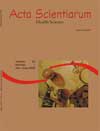Pharmacovigilance at Regional University Hospital in Maringá, PR
Abstract
This work describes the investigative experience of suspected cases of adverse drug reactions reported at Regional University Hospital of Maringá. Data collection and home visit procedures are described as both - a way to clarify the diagnosis; a way to provide these people and their family information about using and storage of medication. From 1996 to 2000, 316 cases of suspicious adverse drug reactions were registered. From the total, in only 105 cases the home visit was carried out. The application of the Algorithm of Naranjo allowed classifying the suspicious cases in evident cases (4,8%), probable (56,7%), possible (34,6%) and doubtful (3,9%). It was also verified that most of the notifications originate from active search in medical files and that the spontaneous reporting are still few. Therefore, strategies should be developed to increase spontaneous reporting of suspected adverse reaction to drugs by health professionals, independently of the seriousness or unusualness of the suspected reactionDownloads
Download data is not yet available.
Published
2008-04-24
How to Cite
Nishiyama, P., de Souza Bonetti, M. de F., Feitoza Bohm, A. C., & Margonato, F. B. (2008). Pharmacovigilance at Regional University Hospital in Maringá, PR. Acta Scientiarum. Health Sciences, 24, 749-756. https://doi.org/10.4025/actascihealthsci.v24i0.2504
Issue
Section
Health Sciences
DECLARATION OF ORIGINALITY AND COPYRIGHTS
I Declare that current article is original and has not been submitted for publication, in part or in whole, to any other national or international journal.
The copyrights belong exclusively to the authors. Published content is licensed under Creative Commons Attribution 4.0 (CC BY 4.0) guidelines, which allows sharing (copy and distribution of the material in any medium or format) and adaptation (remix, transform, and build upon the material) for any purpose, even commercially, under the terms of attribution.
Read this link for further information on how to use CC BY 4.0 properly.























5.png)







